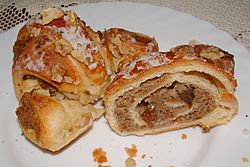St. Martin's croissant facts for kids

Rogal świętomarciński
|
|
| Type | Pastry |
|---|---|
| Place of origin | Poznań, Poland |
| Main ingredients | Dough, poppy seed-almond filling |
The St. Martin's croissant (called rogal świętomarciński in Polish) is a special type of croissant. It has a yummy white poppy seed filling inside. People traditionally make and eat these croissants in the city of Poznań and parts of the Greater Poland region. They are especially popular on St. Martin's Day, which is celebrated every year on November 11.

This special croissant is so important that its name, rogal świętomarciński, is officially protected. The European Commission added it to a special list in 2008. This means only croissants made in a certain way and in a specific area can use this name. It helps keep the tradition alive!
The Story Behind the Croissant
The tradition of making these croissants is very old. It goes back to ancient times, even before Christianity. Back then, people celebrated autumn feasts. They would offer oxen to their gods. Sometimes, they used dough shaped like oxen horns instead.
Later, the Latin Church adopted this custom. They connected it to Saint Martin. The croissant's shape was thought to look like a horseshoe. This was a nod to the horse Saint Martin rode.
In Poznań, people were definitely baking 'rogal świętomarciński' by 1860. We know this because the oldest known advertisement for it appeared in a newspaper called Dziennik Poznański.
A Popular Legend: Helping the Poor
There is a famous story about how the tradition became what it is today. This legend says it started in November 1891. The priest of St. Martin's parish, Father Jan Lewicki, asked his church members to help the poor. He wanted them to follow the example of Saint Martin.
A baker named Józef Melzer was at the church service. He worked in a nearby bakery. Józef convinced his boss to bring back the old croissant tradition. Wealthier people in Poznań would buy the delicious croissants. The poor people would then receive them for free.
This kind act became a custom. In 1901, the Association of Confectioners took over the baking tradition. After World War I, Franciszek Rączyński continued giving croissants to the poor. And after World War II, Zygmunt Wasiński made sure the croissant was not forgotten.
What's Inside a St. Martin's Croissant?
The filling of a St. Martin's croissant is very specific. It must be made from white poppy seeds. It also includes vanilla, crushed dates or figs, and raisins. Cream is added to make it smooth and rich.
After baking, the croissant is covered with a sweet sugar icing. Then, it's sprinkled with crunchy peanuts. This makes it extra delicious!

